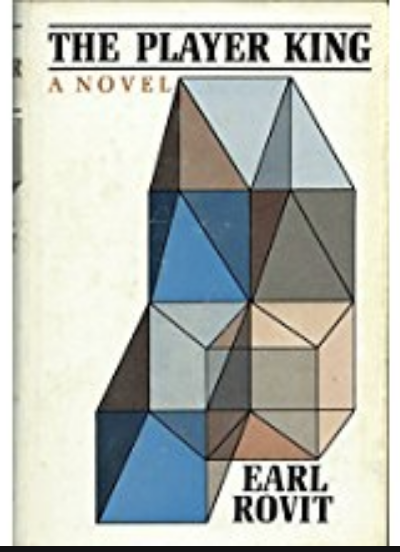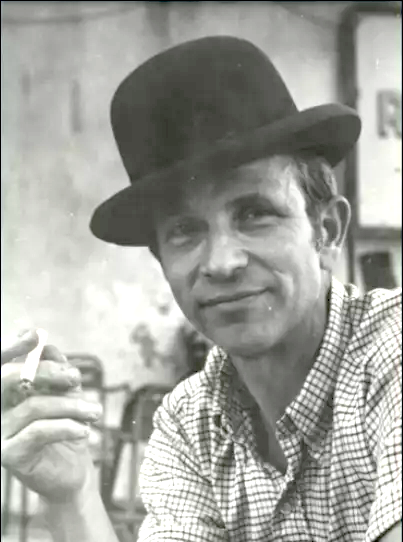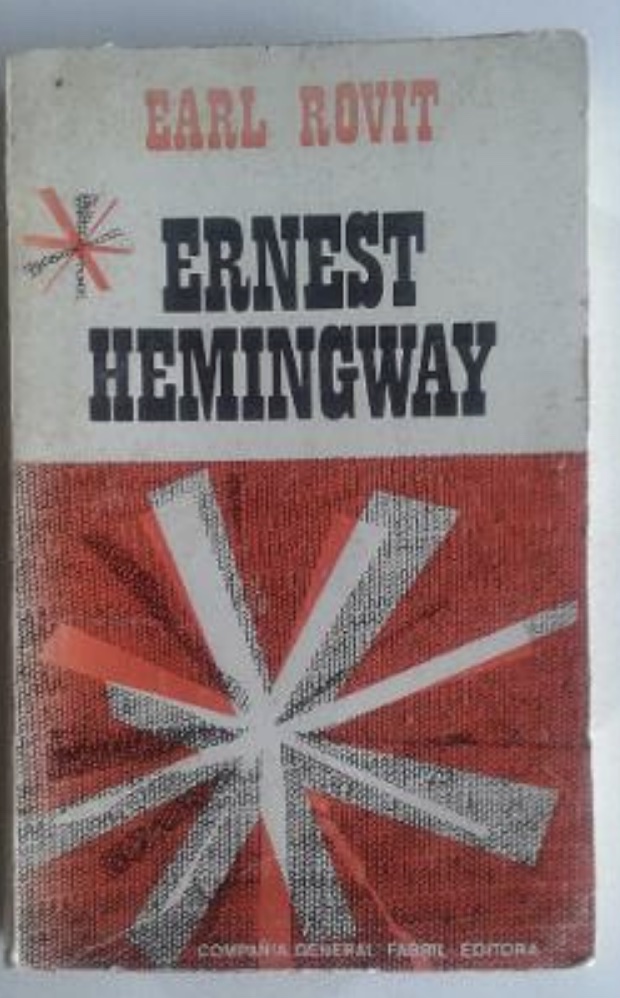Go back to my home
page.
The letter is also Chapter 11 of
my book Recuerdo
de amnesia/Memory of Amnesia
After Buddy Rovit's death at
90 years of age,
His cousin
contacted me because I had shared the
link to
this letter. HERE
IS THE CORRESPONDENCE.
Earl Rovit
April 23, 2013
New York, NY
Dear Dr. Rovit,
I'm not sure if you would remember me at all
since I only knew you when I was a child in
Louisville, Kentucky in around 1956 or so. I
am the son of Gerald A. Cole and Jean H. Cole
and we lived in Kentucky where my father, a
biology professor, worked at the University of
Louisville. They were friends of yours. My
parents' closest friends in Kentucky were Bill
and Mary Furnish.
I'm writing simply because I'm curious to know
if my memory of so long ago is correct or not.
I hope you might respond to this letter and I
hope that you might find it of interest in any
case.
Here's what I remember. You had a convertible,
a big (yellow or beige?) beast and my two
brothers and two sisters and I more than once
rode in the back in comfort and style through
the city to your house. It was a thrill for us
to be in such a grand kind of automobile and
to feel the air rushing by. It was so
different from riding in the woody station
wagon in which we traveled to Alaska and back
again in 1955.
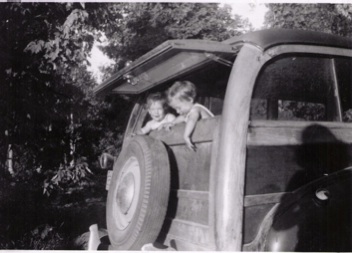
| Woody that
we went in to alaska. La furgoneta en la
que viajamos a Alaska junto con los
Furnish. Se puede ver la sombra de mi
madre que está tomando la foto. WAIT.
This is a different car. They must have
bought a slightly newer model for the
Alaska trip. The next two pictures are
really from the trip and look at the
difference. |
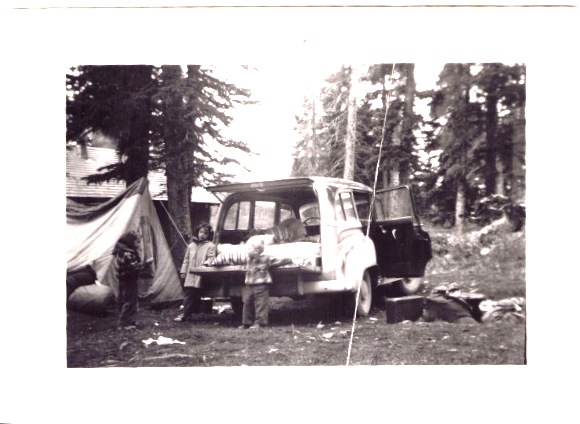
I guess this is not the same car
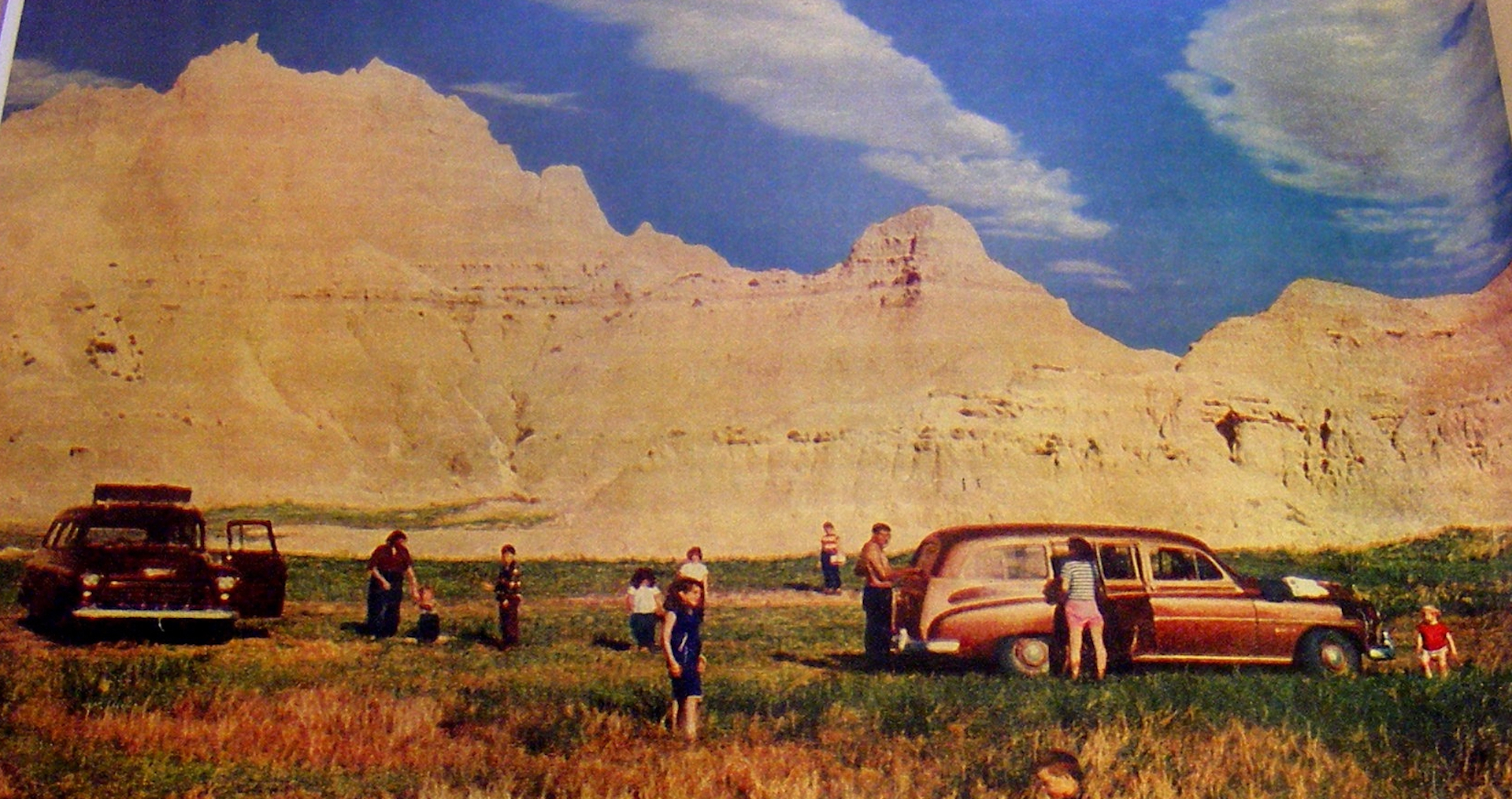
HERE'S WHERE WE MET THE FURNISHES ON THE WAY. THE
BADLANDS OF SOUTH DAKOTA.
FURNISH BILL AND
MARY
You lived on
the top of a hill and my memory has no
vision of any other house atop it. Only
yours.
We knew you as "Buddy Rovit." You told us
kids a tale of a magic marble, a blue one,
with which you could communicate and get
advice for yourself and for us. We were very
young and were totally credulous and thus
fascinated. We wanted to see the blue magic
marble, but you said that it had been lost
in the brush on the side of the house.
Naturally the five of us immediately set to
searching for it.
We came up with a green marble that had to
suffice. You said that you knew the green
marble and that it, too, was indeed a magic
one, and held it to your ear and told us
what it was telling you. I cannot remember
what you said the marble had to say.
We children believed you to be fabulously
wealthy living up on the hill and driving a
three-hole convertible Buick (or whatever it
was), and I have a vivid memory of sitting
with you and your wife Honey in your living
room. We were children and shy and naïve,
not knowing much in the way of propriety and
one of us asked aloud, "Why are you so
rich?"
"I know," said my sister. "Because Honey is
an artist."
We were under the impression that artists
made a lot of money. Perhaps it was because
Jon Gnagy in those days was an artist on TV
and people on television certainly had to be
rich, but that's only a guess.
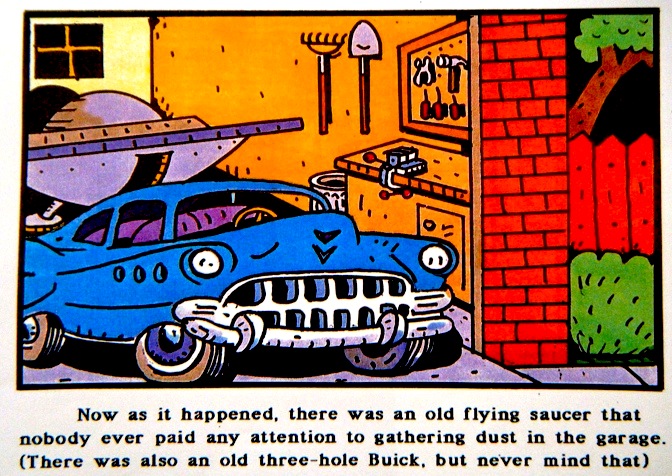 Here's a THREE-HOLE BUICK
Here's a THREE-HOLE BUICK
 There appears to also be a "Four-hole Buick."
There appears to also be a "Four-hole Buick."
I remember
years later in Tempe, Arizona I mentioned
Buddy Rovit, and my mother said that you had
published a book on Hemingway. I don't
remember if she had a copy, but she may have
as she liked Hemingway.
In 1961, when I was ten I was riding in the
car with my mom driving and she suddenly
blurted out what she had just heard on the
radio, "Ernest Hemingway died!"
At any rate, these memories come to me when
I think of my childhood and when my brother
and I play "Let's Have a Hemingway
Conversation:"
"You're a worthless rummy, aren't you?"
"True enough perhaps but you needn't say so
to my face."
"You're a miserable rotter."
"You say the most bloody awful things..."
As you can see, we aren't very good at it,
but it's fun.
I should have consulted my brothers and
sisters to check their memories before
writing, but I can ask them later. My
parents have passed on, so I can't ask them.
Anyway, I'm only writing out of personal
curiosity about some fond memories of mine.
I'm hoping that you might be kind enough to
reply.
Yours truly,
Tom Cole
On May 10,
2013, at 7:42 AM, Earl Rovit emailed me:
In the letter which at this very moment is
crawling to you across the USPS system, I
forgot to note that Yes, we were filthy rich
at Louisville. I not only had a salary of
$4200 a year (four courses a semester, I
think) but I had the option of teaching in
the summer and in the Adult Education
programs at night. Jerry probably did as
well, but I don't
know. Bud
I
emailed him back May 10, 2013 10:49:42 AM
MST To: Earl Rovit
When I
got a lot older, I realized that you
probably weren't rich.
Looking forward very much to the snail mail.
Yours,
Tom
Dear Tom:
What a pleasant and unexpected surprise to
get your articulate, detailed,
sometimes-right, sometimes-wrong memories of
some sixty or so years ago. Of course I
remember Jerry and Jean who were among my
very favorite people in Louisville. (Bill
Furnish, as well,
although he was more distant, wittier, and
sort of on the sidelines.) Your father—as I
recall—remained in the Air Force reserve and
would spend something like one Saturday a
month flying three or four thousand miles in
the new jet fighters to retain his active
status and I was very envious of that. (I
had been in the infantry.) I can’t remember
how many children you were but I do recall
Jerry announcing that the most recent
addition would be named “Terminus.” And I
also can’t remember if you folks left
Louisville before I did. We did have a
convertible—a powder blue Ford—which I
traded away for a Rambler when our first
child was born in 1958. Your recollections
of the house on the hill are vaguely
accurate. It was on a hill, but it had been
the slave quarters of a larger house which
was a little higher than ours. The marbles
elude me, but it was the kind of story
interaction with kids which I tended to
engage in and enjoy. Not at that time having
children of my own, I thought your family
was sort of ideal. In fact, the few years I
spent at Louisville (I was in my 20’s) were,
on the whole, quite happy ones. I liked the
town, I liked the University, I liked my
colleagues, I liked the students and I was
learning how to be a teacher. A great deal
of water—in fact, floods and floods of
it—some glistening silver, some flotsam—have
passed under the bridge since, but my
Louisville memories are almost entirely
happy ones, And I thank you for refreshing
them for me.
Again, thank you
New York, NY 10023
Here's his
envelope:
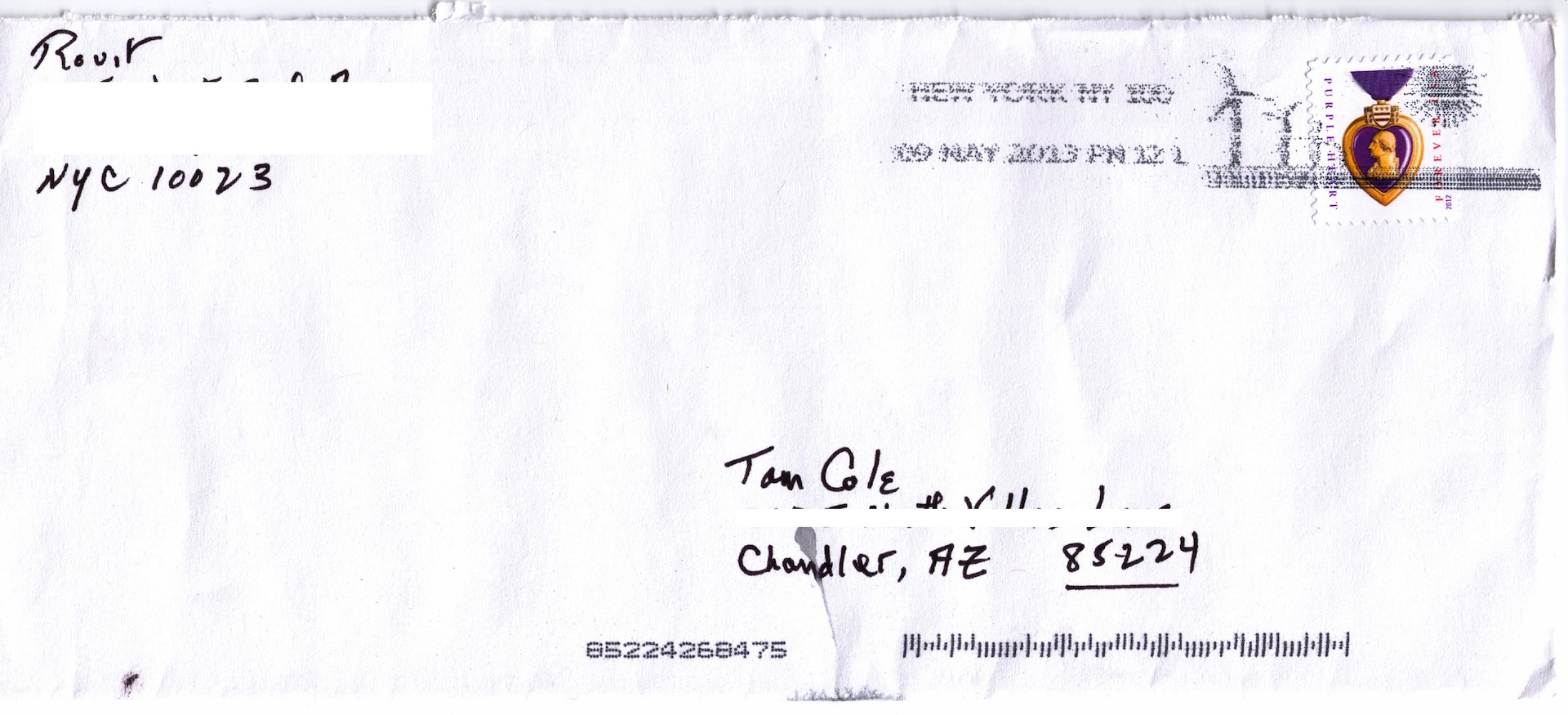
And the letter itself:
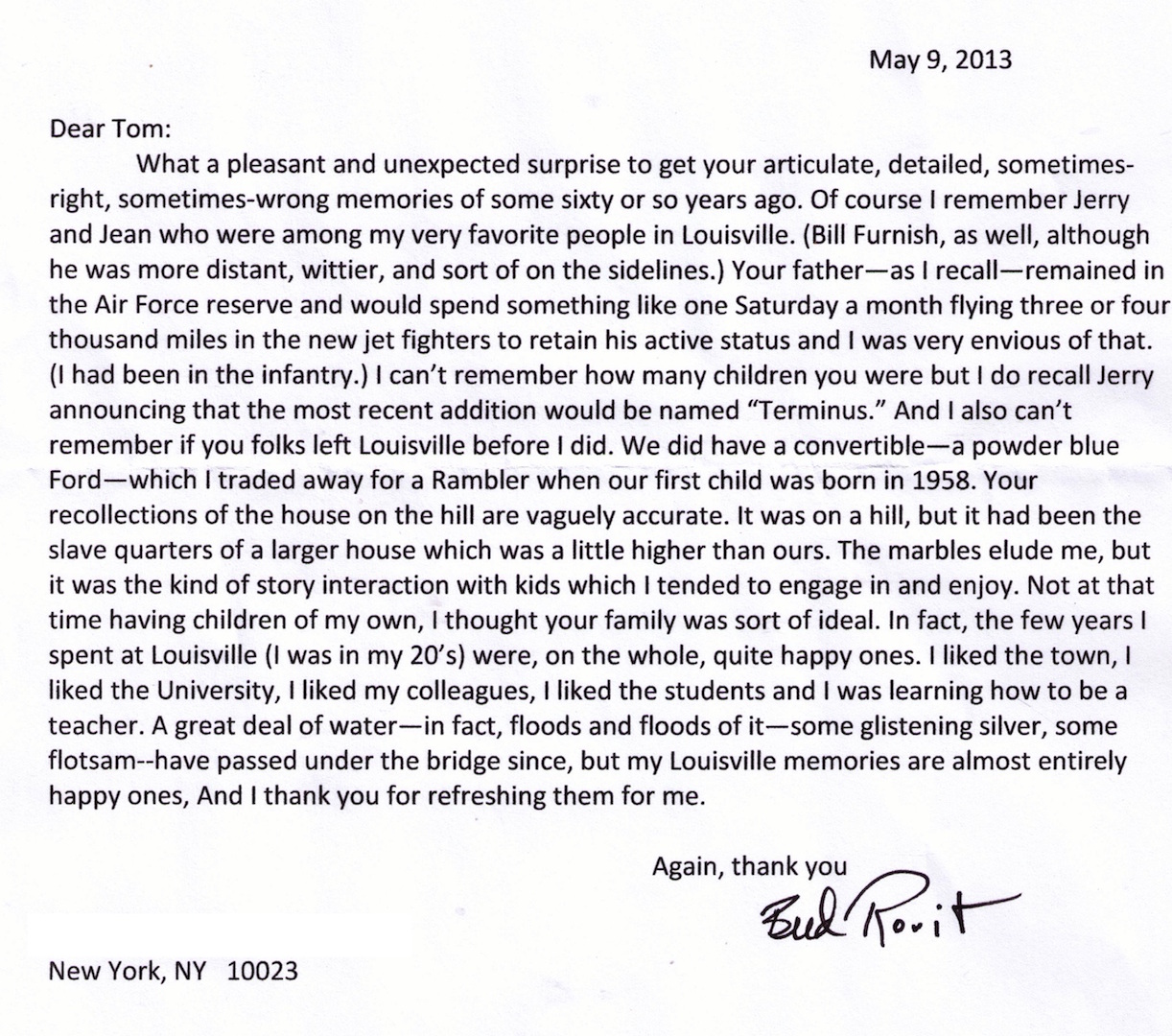
DOGGONE IT! LOOK BELOW.
The Fulbright Association is
deeply saddened by the passing of
Lifetime Member Earl “Bud” Rovit, an
internationally acclaimed literary
scholar and four-time Fulbright
recipient.
Rovit, a leading literary
scholar of the writing of Ernest
Hemingway, Ralph Ellison, Saul Bellow
and William Faulkner, and in the early
1960’s, one of the first to discern
and explore what became known as the
Jewish American literary tradition,
including writers such as Bellow,
Bernard Malamud, Norman Mailer and
Philip Roth, died April 16 in New York
City. He was 90.
Rovit was a Professor of
American Literature at the City
College of New York from 1966 to his
retirement in 1996. Over the course of
a career that began in 1955, he was
the recipient of Guggenheim and
National Endowment for the Humanities
Fellowships, and four Fulbright
Professorships (Germany, France, China
and India).
He published Ernest
Hemingway in
1963 and it was translated into 12
languages. A revised edition in
collaboration with Gerry Brenner was
released in 1986. In addition to six
books of literary criticism and over
sixty journal articles, essays and
literary criticism for publications
including The Sewanee Review, the Yale
Review, and the Southern Review, he
was the author of three critically
acclaimed novels: The
Player King, A
Far Cry, and Crossings.
Peter Collier, writing in
the New York Times Book Review in
1967, said “A Far Cry is
both deft and audacious. Rovit,
demonstrating a respect for
traditional craftmanship, endows each
of the narratives with its own
suspense and catharsis.”
Crossings,
published in 1973 was a novel in the
form of two journals, a husband’s and
a wife’s, bound back to back. Readers
could choose to explore the events of
a single day by starting with either
journal. “…[N]ot only does it develop
a complex historical theme, but
beneath its glittering surface are the
enduring rhythms of literature, and of
myth…”, wrote Mark Taylor in
Commonweal.
Earl, known to friends as
Bud, was born May 26, 1927 in
Brookline, MA to Samuel Rovit, a truck
driver, and the former Frances ‘Jenny’
Ehrenberg. He was educated at the
Boston Latin School, and attended the
University of Michigan before leaving
to serve in the U.S. Army in Korea. He
later finished his degree at Michigan,
and received his MA and PhD at Boston
University.
In addition to his teaching,
writing and family, he was most proud
of having completed two New York City
Marathons in his 50s.
His only sibling, Dr.
Richard L. Rovit, former Chief of
Neurosurgery at St. Vincent’s Hospital
in NYC, preceded him in death by one
week. He is survived by his wife,
Honey; three children, Sam, Rebecca
and Peter; and six grandchildren. His
daughter, Rebecca, is also a Fulbright
alumna, having served as a
Fulbright-IFK Senior Fellow in
Cultural Studies in Vienna, Austria in
2016-2017.
The Sewanee
Review has
received word that longtime
contributor Earl H. Rovit passed
away on April 16 at the age of
ninety. Rovit was a contributor of
essays and criticism to the Review for
over forty years. A leading
literary scholar of the writing of
Ernest Hemingway, Ralph Ellison,
Saul Bellow and William Faulkner,
Rovit was one of the first in the
early 1960s to discern and explore
what became known as the Jewish
American literary tradition,
including writers such as Bellow,
Bernard Malamud, Norman Mailer,
and Philip Roth. One highlight of
his illustrious career was
publishing Ernest
Hemingway, a book of
critical interpretation and
discussion of the
author’s works. Rovit also
published three novels, The
Player King, Crossings,
and A
Far Cry, which the New
York Times Book Review called
“deft and audacious.” We mourn the
loss of this great literary mind
and remember his many outstanding
contributions to our publication,
most recently the essay
“Confessions of a Renter” in the
Summer 2012 issue.
Earl Rovit
23
abril, 2013
New York, NY
Querido Dr. Rovit,
No estoy seguro si me recuerda, ya que
solamente le conocía de niño en Louisville,
Kentucky cerca de 1956. Yo soy el hijo de
Gerald A. Cole and Jean Hascall Cole y
vivíamos en Kentucky donde mi padre, un
catedrático de biología, trabajaba en la
Universidad de Louisville. Eran amigos
suyos. Los amigos más cercanos de mis padres
eran Bill y Mary Furnish.
Escribo nada más porque me gustaría saber si
mi memoria de hace tantos años es correcta o
no. Espero que Ud. me conteste y de todas
maneras espero que encuentre esta carta
interesante.
Lo siguiente es lo que me acuerdo: Ud. tenía
un convertible, un monstruo grandote
(¿amarillo o beige?) y mis dos hermanos, dos
hermanas y yo más de una vez viajábamos en
la parte trasera con un estilo sofisticado
por la ciudad rumbo a su casa. Era muy
emocionante estar en un automóvil tan grande
y sentir el viento que soplaba. Era muy
diferente que viajar en la furgoneta
familiar en la que viajamos a Alaska y
de vuelta en 1955.
Vivía Ud. en la cima de una colina y no
recuerdo haber visto ninguna otra casa allí;
solamente la suya.
Le llamábamos “Buddy Rovit.” Nos dijo un
cuento de una canica mágica, una azul, con
que podría comunicarse y obtener consejo
para Ud. y nosotros. Éramos muy jóvenes y
totalmente crédulos y por eso encantados y
fascinados. Queríamos ver la canica azul
pero Ud. nos informó que se había perdido en
las matas junto a la casa. Por supuesto los
cinco empezábamos a buscarla de inmediato.
Encontramos una canica verde que tenía que
ser suficiente. Ud. dijo que conocía la
canica verde y que también era mágica. La
puso a su oído y nos dijo lo que le
estaba diciendo. No me acuerdo lo que Ud.
dijo que le dijo.
Nosotros creíamos que Ud. era fabulosamente
rico porque vivía en la colina y conducía un
convertible Buick “de cuatro agujeros” (o lo
que era) y tengo un recuerdo vivo de estar
sentado en su sala con Ud. y su esposa,
Honey. Éramos niños tímidos e ingenuos y
como no sabíamos mucho de lo adecuado uno de
nosotros les preguntó:
—¿Por qué son ustedes tan ricos?
—Yo sé —dijo mi hermana. Es porque Honey es
artista.
Creímos que los artistas ganaban mucho
dinero. Tal vez sea debido a que en aquel
entonces un Jon Gnagy era artista en la
televisión y la gente en la televisión sin
duda ha de ser rica, pero solamente adivino.
Recuerdo que
años más tarde en Tempe, Arizona yo mencioné
Buddy Rovit y mi madre me informó que Ud.
había publicado un libro sobre Hemingway. No
me acuerdo si ella tenía una copia, pero es
posible que sí ya que a ella le gustaba
Hemingway.
En el año de 1961 cuando yo tenía diez años
estaba en el coche con mi madre y de repente
gritó lo que acababa de oír en la radio:
—¡Se murió Ernest Hemingway!
De todos modos, estas cosas me vienen a la
memoria cuando pienso en mi juventud y
cuando mi hermano y yo jugamos “Vamos a
tener una conversación estilo de Hemingway.”
—Ud. es un inútil borrachín, ¿no es así?
—Lo cierto es que tal vez, pero no es
necesario que lo diga a la cara.
—Ud. es un canalla miserable.
—Ud. dice que las cosas más jodidamente
terribles.
Ud. claramente puede ver que no somos muy
buenos para hacerlo pero es divertido.
Yo debería haber preguntado a mis hermanos
para saber su recuerdos antes de escribirle
pero les puedo preguntar más tarde. Mis
padres se han ido así que no les puedo
preguntar.
De todos modos, escribo solamente de
curiosidad de algunas memorias predilectas
mías. Espero que Ud. tenga la bondad de
responder.
Atentamente,
Tom Cole
El 10 de Mayo, 2013, a las 7:42 AM
En la carta que ahora mismo está llegando a
Ud. a paso de tortuga por el sistema de
correo de Estados Unidos se me olvidó
decirte que sí éramos asquerosamente ricos.
Yo no solamente tenía un sueldo de $4200 al
año (cuatro clases al semestre yo creo) pero
tenía la opción de dar clases durante el
verano en el programa para los adultos en la
noche. Jerry probablemente hizo lo mismo,
pero yo no sé.
Bud
El 10 de Mayo, 2013, a las10:49 AM
Cuando ya estaba más viejo, me di cuenta de
que probablemente no eran ricos.
Me ilusiona recibir la carta.
Tom
9 mayo
2013
Querido Tom,
Qué sorpresa amena e imprevista fue recibir
sus articuladas, detalladas, algunas veces
correctas, pero otras veces equivocadas
memorias de hace algunos sesenta años. Por
supuesto me acuerdo de Jerry y Jean quienes
estaban entre mi gente más preferida en
Louisville.
(Bill Furnish, también, aunque él estaba más
lejano, ingenioso, y al margen.) Tu padre —
como me acuerdo — se quedó en las reservas
de las fuerzas aéreas y pasaba algo como un
fin de semana al mes piloteando tres o
cuatro mil millas en los nuevos aviones de
reacción para mantener su estado activo y yo
me sentía muy envidioso de eso. (Yo había
estado en la infantería.) No puedo recordar
cuántos niños eran ustedes pero recuerdo que
Jerry proclamó que la adición más reciente
se llamaría “Terminus.” Tampoco me acuerdo
si ustedes salieron de Louisville antes de
mí. Es cierto que teníamos un convertible,
un Ford azul pálido que yo cambié por un
Rambler cuando nació nuestro primer niño en
el año de 1958. Sus recuerdos de nuestra
casa son más o menos precisos. Estaba
situada en una colina, pero era la vivienda
de sirvientes de una casa más grande que
estaba un poquito más arriba que la nuestra.
Se me escapa el cuento de las canicas, pero
era la clase de cuento y interacción con los
niños en que yo tendía meterme y disfrutar.
No teniendo niños míos, yo creía que su
familia era más o menos ideal. (Yo tenía
veintitantos.) En efecto, los pocos años que
pasé en Louisville fueron, por regla
general, años bastante alegres. Me gustaba
el pueblo, me gustaba la universidad, me
gustaban mis colegas, y estaba aprendiendo a
llegar a ser maestro. Ha llovido mucho desde
entonces. De hecho han habido algunas
tormentas grandes y poderosas que han traído
tanto lluvia plateada y reluciente como
escombros, pero mis recuerdos de Louisville
son casi completamente dichosos y te
agradezco por recordármelos.
 Otra vez,
gracias.
Otra vez,
gracias.
DOGGONE IT! LOOK BELOW.
The Sewanee Review has
received word that longtime
contributor Earl H. Rovit
passed away on April 16 at
the age of ninety. Rovit was
a contributor of essays and
criticism to the Review for
over forty years. A
leading literary scholar of
the writing of Ernest
Hemingway, Ralph Ellison,
Saul Bellow and William
Faulkner, Rovit was one of
the first in the early 1960s
to discern and explore what
became known as the Jewish
American literary tradition,
including writers such as
Bellow, Bernard Malamud,
Norman Mailer, and Philip
Roth. One highlight of his
illustrious career was
publishing Ernest Hemingway,
a book of critical
interpretation and
discussion of the
author’s works. Rovit
also published three
novels, The Player King, Crossings,
and A Far Cry,
which the New York Times
Book Review called
“deft and audacious.” We
mourn the loss of this great
literary mind and remember
his many outstanding
contributions to our
publication, most recently
the essay “Confessions of a
Renter” in the Summer 2012
issue.
|
